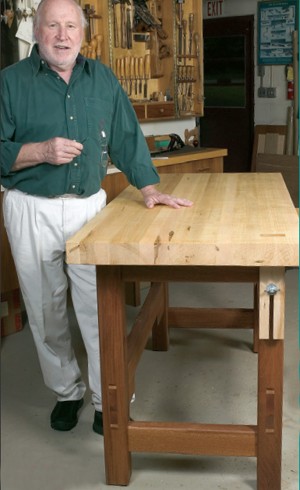
Workbenches are great. They have opened up hand tools to my skill set. A good bench makes woodworking more enjoyable. But shouldn’t workbenches be dead flat? Why am I told that a $3,500 workbench is going to warp and change with the weather just like the one I purchased for $400? The workbench that I have has a crown of about 1/8 of an inch in the center. Is this normal? Hand planing down a beech workbench is not easy work. What am I missing? I might expect this from a Harbor Freight $100 bench, but $400 is a lot of money. – Barney Heller
Chris Marshall: Barney, a flat reference surface on which to work is important. How “dead flat” though, is a matter of some debate. If you need to evaluate the flatness of a glued-up drawer or panel, or whether four chair legs will stand evenly on a surface, it helps to have a workbench top that you can reliably say is “flat.” But, workbenches are made of wood, and wood moves. So do structures we make out of wood, depending on how they’re built. There are some efforts we can make to minimize that reality, such as building really stout undercarriages for workbench tops or face-gluing the tops “butcher block” style instead of edge-gluing them, but we can’t completely thwart wood from moving.
Like yours, my $900 bench has a distortion in its top, too. Despite this, I do use it as a staging and assembly surface, but when I want to know how truly flat a workpiece is, I lay that on my cast-iron table saw or jointer bed, or get out some winding sticks or a steel rule and check it that way. I don’t consider my workbench top to be flat enough. But, does it work well enough for what I need it to do most of the time? Yes. Do I want to go to the trouble of flattening the top by hand? Not really, because I think the construction of the undercarriage of my bench wouldn’t help prevent distortion from happening again. The framework just isn’t stout enough. When I need even flatter referencing surfaces, I know where in the shop to turn. But, I’m sure there are woodworkers here who will take issue with my approach and say it all begins and ends with a super flat benchtop … and I won’t argue with them. The flatter, the better. How flat is flat enough? That’s a matter of preference.
Tim Inman: Yes, workbenches should be flat. But, whether you paid $5,000 or $5, if the bench is constructed of wood, it will want to move around. Warping, twisting, shrinking and swelling are all part of the wonders of our favorite natural substrate, wood. Torsion box construction will typically give a better chance for long-lasting dimensional stability, including flatness. My cast-iron table saw top is my “go-to” standard for flatness, though. Machinists use granite surface plates for their flatness needs. I’d get your benchtop as flat as is reasonably possible, and enjoy it for what it is. Price isn’t an indicator of quality, unfortunately, nor is it a guarantee that wood will stay put.






